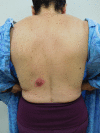Staphylococcus lugdunensis Infections of the Skin and Soft Tissue: A Case Series and Review
- PMID: 29022273
- PMCID: PMC5698201
- DOI: 10.1007/s13555-017-0202-5
Staphylococcus lugdunensis Infections of the Skin and Soft Tissue: A Case Series and Review
Abstract
Introduction: Staphylococcus lugdunensis (S. lugdunensis) is a coagulase-negative, Gram-positive bacterium that can be isolated as a component of normal skin flora in humans. However, more recently, it has also been documented as a culprit in skin and soft tissue infections. We describe the clinical features of five individuals with S. lugdunensis-associated skin infections. We review the characteristics of other patients that were previously described with this organism as the causative agent of skin infection.
Methods: Staphylococcus lugdunensis was correlated with the development of significant skin and soft tissue infections in five patients. The Pubmed database was used to search for the following terms: "abscess," "cellulitis," "cutaneous," "lugdunensis," "paronychia," "skin," "soft," "staphylococcus," and "tissue." The relevant and reference papers generated by the search were reviewed.
Results: One woman and four men developed S. lugdunensis-related skin infections from February 19, 2015 to May 30, 2017. The patients' ages at the onset of the infection ranged from 30 to 82 years; the median age was 70 years. Four patients were older than 65 years. The back was the most common location for the infection, followed by digits. The infection presented as cystic lesions with cellulitis or periungual abscesses. The lesions were incised or spontaneously ruptured. Patients were empirically treated with oral antibiotics; if necessary, the management was adjusted based on the culture-derived sensitivities of the organisms. The infections resolved within 10-30 days after commencing treatment.
Conclusion: Staphylococcus lugdunensis has previously been considered as a nonpathogenic organism and to be a component of normal skin flora. However, S. lugdunensis can result in significant skin and soft tissue infections, perhaps more frequently in older individuals. Its antibiotic sensitivities appear to be similar to those of methicillin-susceptible Staphylococcus aureus.
Keywords: Abscess; Cellulitis; Cutaneous; Lugdunensis; Paronychia; Skin; Soft; Staphylococcus; Tissue.
Figures





References
-
- Freney J, Brun Y, Bes M, Meugnier H, Grimont F, Grimont P, Nervi C, Fleurette J. Staphylococcus lugdunensis sp. nov. and Staphylococcus schleiferi sp. nov., two species from human clinical specimens. Int J Syst Evol Microbiol. 1988;38:168–172.
LinkOut - more resources
Full Text Sources
Other Literature Sources

